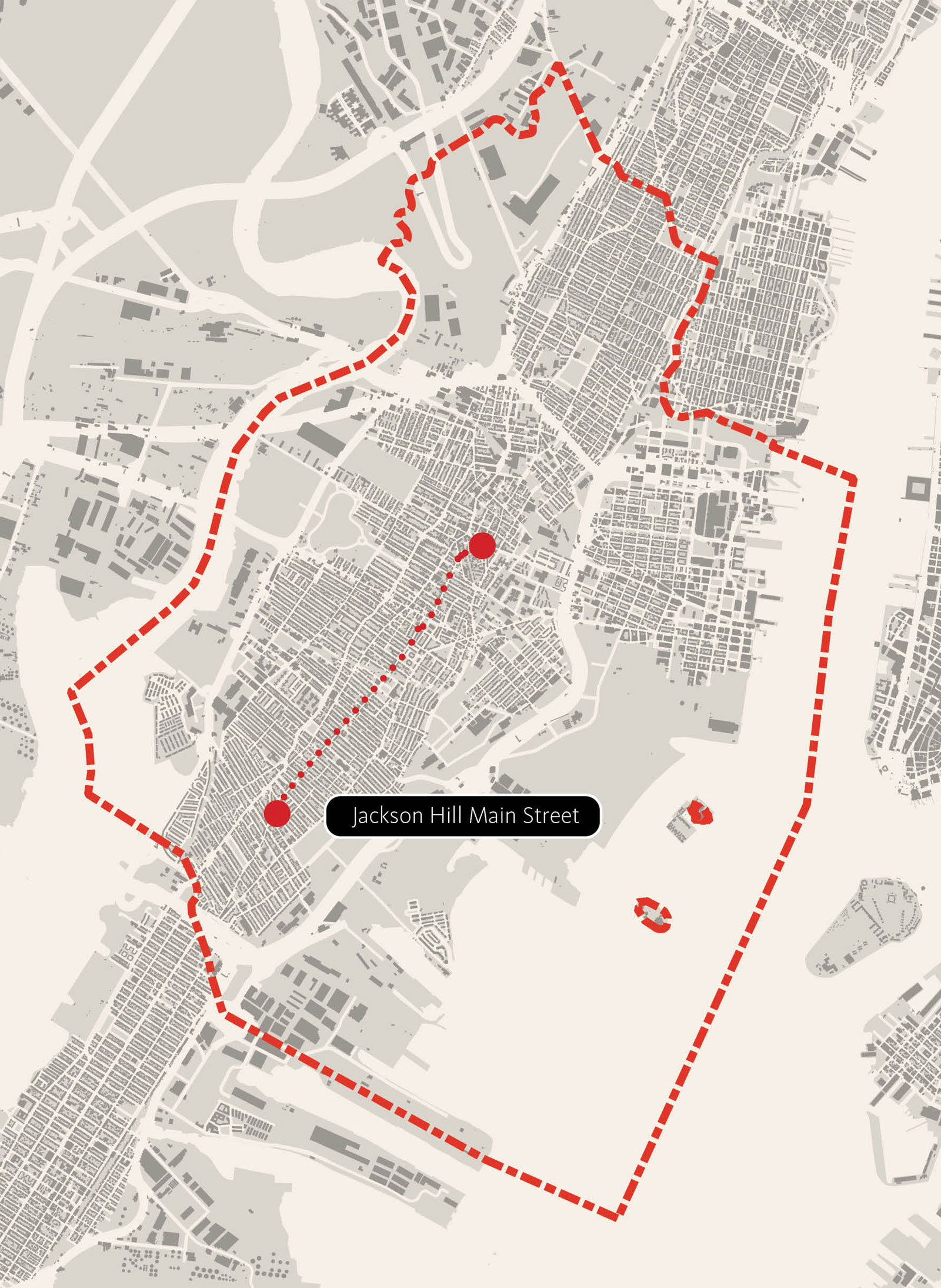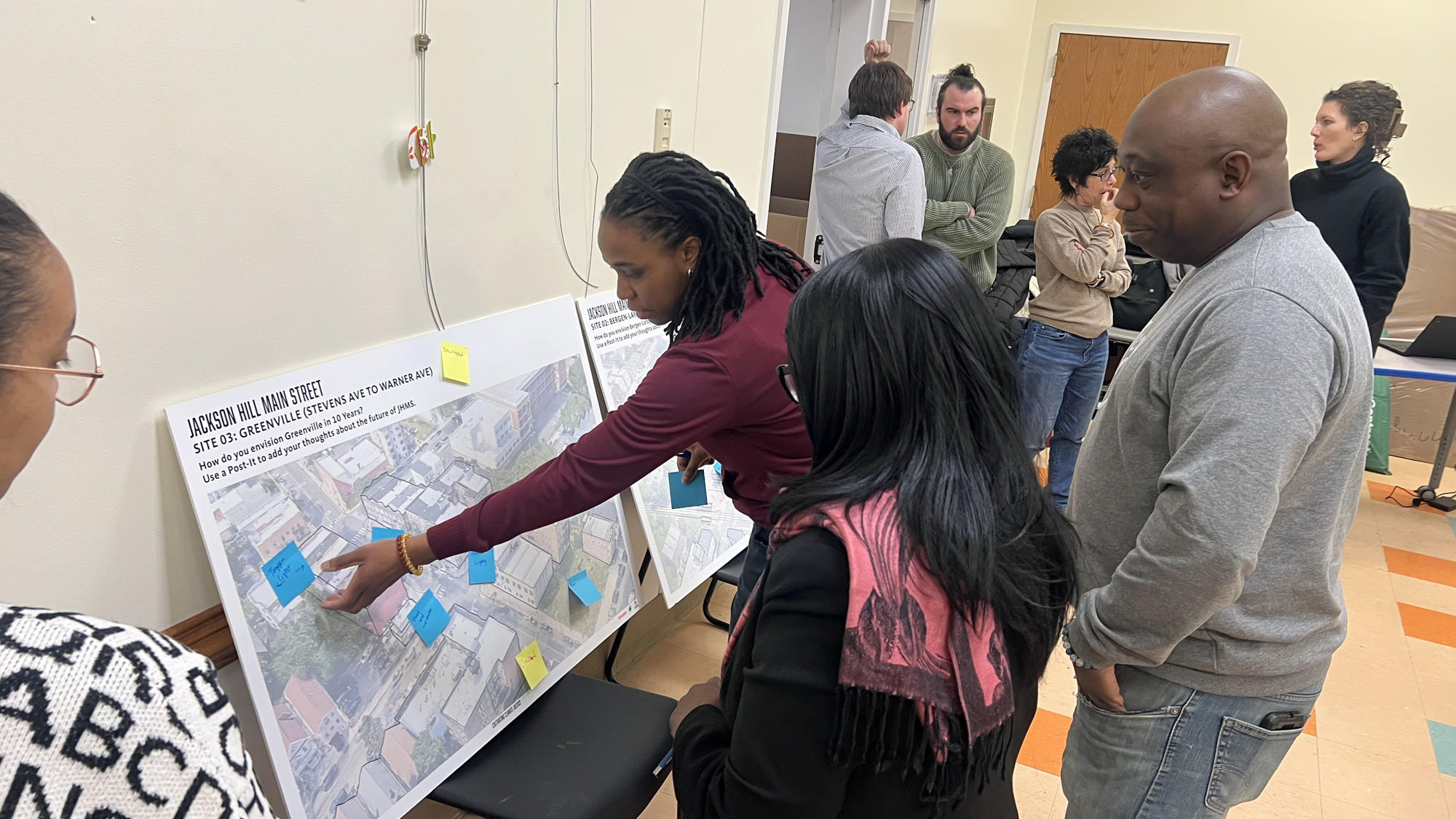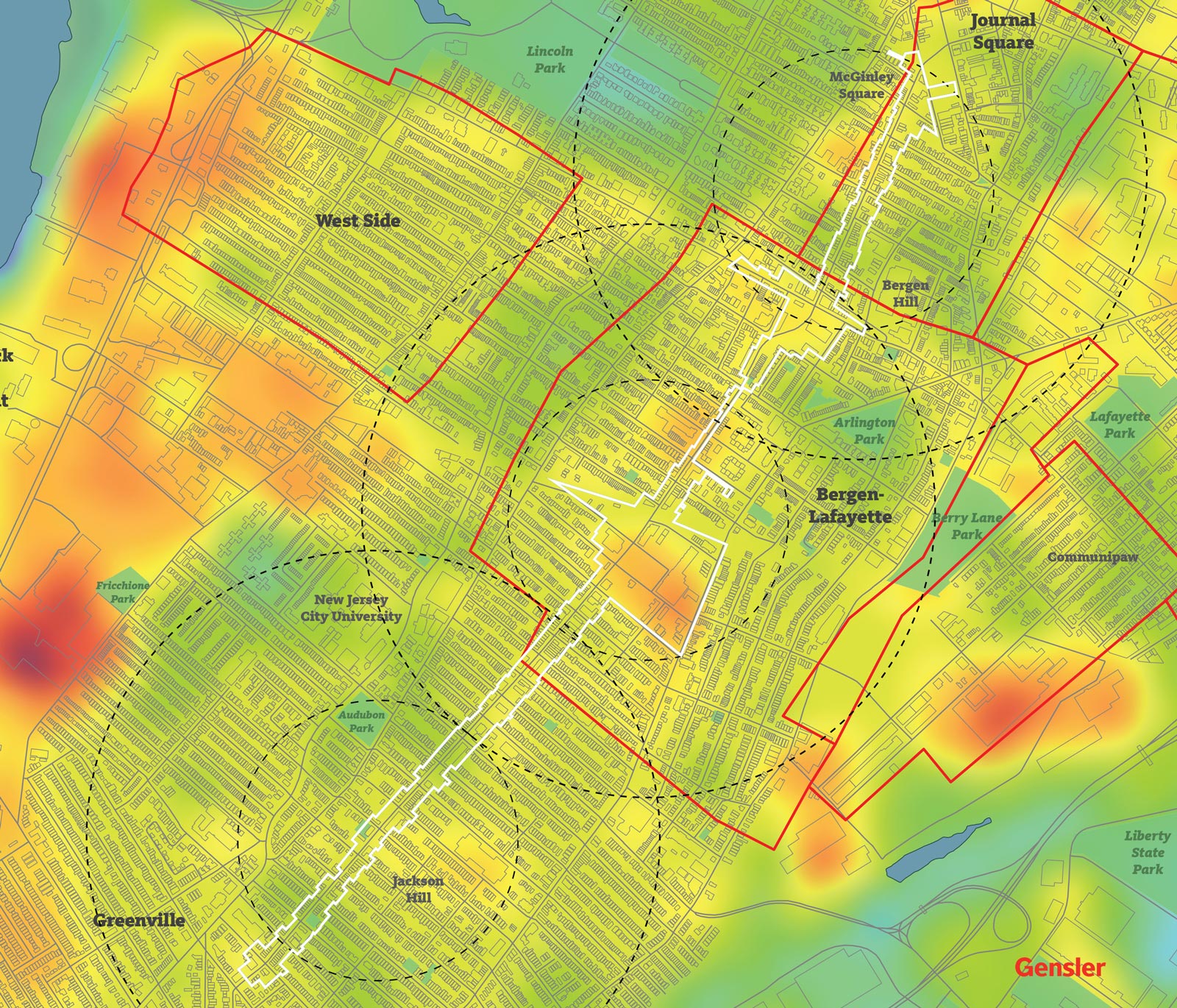10 Opportunities for a More Resilient and Equitable Jersey City
April 28, 2025 | By Roger Smith, John Ferns, Eric Bieber, and Paris Casey
Known as the “Golden Door” to New York City, Jersey City, New Jersey is home to over 265,000 residents across a 15-square-mile footprint. The city is home to both Ellis Island and the Statue of Liberty, and its history is rooted in an economy driven by immigrants working in the shipping and manufacturing industries.
Early in its history, Jersey City had a vision for the future, repurposing old factories into offices and apartment buildings, and abandoned railyards into landscaped parks. Today, the diversity of people and spaces throughout the city offers an opportunity for transformative design solutions that positively impact residents and local businesses. However, the investment and redevelopment has not been equitably distributed throughout the city.

Starting in 2022, Gensler set out to develop strategies that envision climate-conscious, community design interventions at varying scales to make a lasting positive impact on the community. We focused our initial efforts on Jackson Hill Main Street (JHMS), Jersey City’s largest Special Improvement District (SID) that connects multiple neighborhoods along a 2.5-mile stretch. Working in partnership with Sustainable Jersey City (SJC) and JHMS, with input from several departments across the city, Gensler conducted community engagement and visioning sessions. Gensler summarized the various community conversations into a set of design recommendations that help guide our partners in acquiring the necessary grant funding to implement solutions focused on improving environmental resilience, health, safety, equity, and overall neighborhood vibrancy.
Funded by the Gensler Research Institute Center for Research on Equity and the Built Environment, the output incorporated residents, business owners, non-profit partners, board members, and city department representatives looking specifically at three neighborhoods of JHMS: Monticello, Bergen-Lafayette, and Greenville. Our recommendations build on community efforts to improve their district.
Through our conversations with community residents and stakeholders, we identified opportunities for design to enhance environmental, economic, and social resilience in JHMS. Our proposed design solutions are meant to be implemented in future project work, both public and private, through grant funding and collaboration with non-profit partners and the city of Jersey City.

Here are 10 areas of focus to improve climate justice, health, safety, and equity.
- Build neighborhood wealth. Support and grow local businesses across all sectors, creating the opportunity for local entrepreneurs to thrive. Partner with key institutions to activate public spaces. Recommendations include building improvements and prioritization of improving access to capital and wealth building for local business owners and residents.
- Expand retail vibrancy. Transforming the central spine of the district, MLK Drive, into a vibrant walkable retail promenade will activate the streetscape throughout the day while connecting JHMS to other districts in Jersey City. Prioritizing affordable retail spaces for small business owners seeking long-term tenancy will allow commerce to circulate within the district and bolster local ownership and identity.
- Create diversity & affordable housing options. Historically, residents in communities of color were denied access to federal housing loans because of where they lived. Specifically, much of the JHMS district was redlined as Grade C and D. This bias lending practice of redlining had a ripple effect on communities of color for generations, negatively impacting home ownership rates, economic development, and climate justice. As a result of this research initiative, we recommend establishing zoning that supports the vision of JHMS District as a mixed-use lifestyle district composed of three walkable 20-minute neighborhoods, each providing residents affordable housing options above an active retail ground floor.
- Implement safety features. With significant input from the community, allow residents to share responsibility for neighborhood watch while also requesting the city improve walkability and the pedestrian experience at street level through lighting, traffic calming, and creating new bike lanes and stations. As JHMS looks to increase retail tenancy, this strategy will improve activation and eyes on the street throughout the day.
- Improve streets and sidewalks. In addition to enhancing the pedestrian experience with retail and improved safety, the creation of community gardens and addition of vegetation along the corridor will visually and environmentally boost the streetscape of the district. Coupled with efforts to adhere to historic building guidelines, the district will celebrate JHMS’s deep history while transforming the neighborhood into a walkable destination.
- Integrate green infrastructure including more street trees. As a high point between the Hudson and Hackensack Rivers, the district is prone to urban heat island effect and flooding due to insufficient drainage and a high percentage of impervious surfaces. Infrastructure improvements like storm drains, pavement upgrades, and increasing pervious surface coverage are long-term solutions necessary to address climate change now and in the future. The lack of tree coverage in the district paired with large amounts of paved surfaces contribute to the urban heat index. In addition to green infrastructure and urban forestry considerations, we are proposing shade structures to further mitigate the heat island effect.
- Expand access to healthy food. Health is Wealth; increasing access to existing sources of healthy food such as supermarkets throughout the district is the first step. Community gardens and urban farming installations, temporary or permanent, can serve as sites of local food production and healthy food access points for the community. Additionally, green or cool roofs provide amenities and urban farming opportunities to residents. The use of vacant spaces to host farmers’ markets and community educational programming can also lead to improved well-being, disease reduction, and promote physical activity.
- Invest in trees and designated green spaces. While the city has received grant funding to plant trees throughout the district, a landscape master plan is needed to identify a mix of species to improve air quality and heat considerations. Green spaces of various dimensions are recommended around key community assets such as schools and the light rail transit hub, which are crucial access locations, amongst others in the district.
- Invest in arts & culture. The Jersey City Mural Arts Program links established and emerging local artists to create a robust public art program the city is well-known for. This initiative from the mayor’s office is an innovative beautification program that reduces graffiti and creates an outdoor art gallery accessible to all. We recommend expanding similar programs in JHMS to help celebrate the story of the neighborhood and its residents. In addition, we recommend creating a better connection between art and public space to support the community of local artists, offer new gathering areas for neighbors, and establish JHMS as an arts and culture destination in Jersey City. It is of keen importance that public art installations are approved by community stakeholders in an effort to represent significant historic and cultural perspectives of the JHMS community.
- Provide transit options. Bikes and alternate modes of transit such as scooters will reduce vehicular traffic congestion, lead to fewer accidents, and activate the streetscape. Improvements to bus stops, bus shelters, traffic mitigation, signals and signage will enable the ease of circulation to and through JHMS. Given the often narrow corridors of the district sidewalks and streets, safety education is a priority as alternative modes of transit are considered.

Our recommendations are based on ongoing research and community visioning between 2022 and 2024, and have culminated in over 1,300 hours of research, planning, and community engagement in addition to 60+ mapping studies and diagrams. Our research methodology was grounded in a historical, environmental, and spatial analysis of the community — ranging from a guided walking tour that provided context on the reality of the place, to the conversations with residents and local organizations like I Love Greenville and Bergen Communities United. The differentiating factor in terms of the relevancy and applicability of our research was the community voices we heard throughout the process.
In addition to these community organizations, Gensler partnered with Rutgers University to lead a “dotocracy” – a brainstorming strategy where groups are presented with multiple solutions aimed at amplifying community voices and, using dots, vote to prioritize the order in which community needs are addressed. The session was held at the beginning of our research and allows for agreement around central strategies and ideas.
We applaud the City of Jersey City, Jackson Hill Main Street Management Corporation, Sustainable Jersey City, and the Jersey City Department of Infrastructure Division of Sustainability for taking this body of research to the next stages. This resource is just the beginning for the future of JHMS and its residents, businesses, and visitors. The countless hours in curating engagement sessions, walking tours, meetings, and assembling many stakeholders will lead to positive changes in the community and set an example for others to follow.
Special thanks to Jackson Hill Main Street and Sustainable Jersey City who were integral partners in this work at every step of the way. We also thank all of the supporting entities as they guided our processes such as Rutgers University and Greater Neighborhood Alliance. Finally, we are especially grateful and excited about the support of the Jersey City Department of Infrastructure Division of Sustainability, the Jersey City Department of Health & Human Services, the Jersey City Department of Housing, Economic Development, & Commerce, along with their City Planning & Community Development Divisions, and the Jersey City Economic Development Corporation.
For media inquiries, email .
Acknowledgements
The entire Gensler Research team would like to give a special thank you to our authors, local partners, municipal representatives, residents, and the Gensler Research Institute for their contributions to developing the research, recommendations, and content featured in this publication.
John Ferns
Eric Bieber
Paris Casey
Maitri Pujara
Brunie Pierre
James Klauder
Selwyn Bachus II
Zach Trattner
Shruti Venkat
Jacqueline Bole
Gensler Research Institute
Tim Pittman
Rives Taylor
Roger Smith
Lisa Cholmondeley
Cindy Coleman
Stephanie Benkert
Stella Donovan
Sustainable Jersey City
Debra Italiano
Ron Petherbridge
Rosy George
Susan Kaplan
Heather Sporn
Galtree Simpson
Tyrone Rose
Otto Moss
Gillian Sarajeant-Allen
Dave Dennis
Adam Saleh
Adam Sharpson
Nicholas Demarco
Michelle Massey
Jamie Rudolph
US EPA Air Quality Monitoring & Environmental Justice Grant Partners:
Jersey City Dept. of Health & Human Services
Jersey City Housing Authority
Sustainable Jersey City
Greater Neighborhood Alliance
Rutgers University - CEED/EOHSI
City of Jersey City
Department of Health & Human Services
Department of Infrastructure
(Including Division of Sustainability)
Department of Housing, Economic Development & Commerce
(Including Division of City Planning and Division of Community Development)
Jersey City Economic Development Corporation
Thank you to all of the stakeholders who participated in the community engagement sessions for this project!




